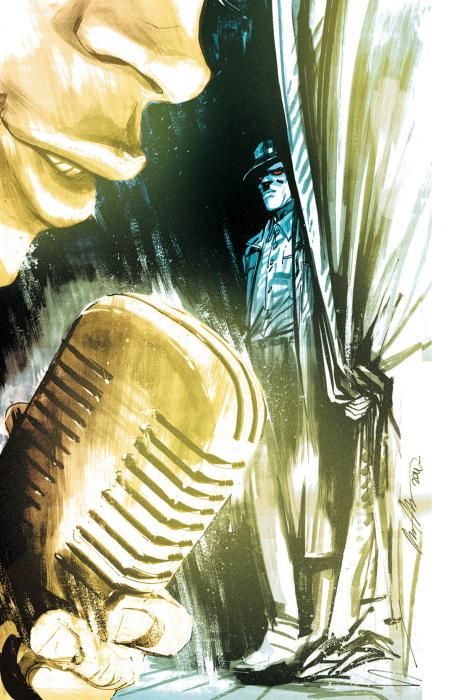Taking a slight detour from the continuing adventures of Skinner Sweet and Pearl Jones, "American Vampire" #26 puts Calvin Poole in the spotlight. Poole was introduced in the "Ghost War" arc and was shown to have not only survived that skirmish, but evolved in the process.
I presume anyone reading a Vertigo book -- and this book in particular -- knows this is not a feel good book. As Scott Snyder has done throughout "American Vampire," this issue is filled with moments designed to make you feel uncomfortable, both in regards to the horrific nature of the subject matter, but also with specific concern to the human condition. Within the context of Alabama in the 1950s, that human condition and the treatment of Poole shouldn't come as a surprise, but the use of the "N word" is still unsettling. Understand it isn't used frivolously throughout this issue, and that Snyder puts it in the framework of the place and time. Snyder then gives Poole the opportunity to exact restitution from those who use the word. Poetic justice at its best, perhaps, but also a grand opportunity to display the ferocity that Calvin Poole, as one of three known Homo Abominum Americana (commonly known as American vampires), keeps in check.
As a member of the Vassals of the Morning Star, Poole serves as a taxonomist. Snyder crawls inside Poole's head like Yoda rummaging through Luke Skywalker's supplies in "Empire Strikes Back," tossing out ideas and motivation the entire time. That makes for a pretty wordy spread six pages into the issue, but it also helps keep the story moving while defining who Calvin Poole is and why the reader should care. Stateside, Poole feels compelled to do some checking up on people he once knew before joining the Vassals, and that simply leads to trouble. Snyder, as he has done with Sweet and Jones, makes Poole a compelling protagonist. Vampires in general aren't characters I think to cheer for, but there's no doubt that Poole is someone I want to see come out of this adventure victorious.
The art by Roger Cruz is pretty good. If I had to choose an artist to fill in on this title, Cruz would not be my first choice, as I tend to think of his style as more inline with the 1990s trends, but he proves me wrong in this issue. The artist manipulates his style to fit the story, calling to mind Rafael Albuquerque's work without blatantly aping Albuquerque too much. There are some panels that are grimacingly close to Albuquerque's efforts, but throughout the vast majority of this issue Cruz simply draws his way. The first five pages are more heavily shadowed than the remainder, effectively making it seem as though Cruz was working in two different methods over the course of "American Vampire" #26. Dave McCaig's colors also make a shift from the opening quintet of pages to the last three-fourths of the issue. McCaig adds in more effects and zipatone dots for depth and texture.
Snyder twists the plot at the end, spinning the story on its head, giving Poole the shock of discovering something new and setting up a confrontation that demands more space than the next issue could possibly allow. Snyder also puts the question out there that's been lurking in my head since the beginning of the series, but at the risk of spoiling the finale, I'll just put it back in my noggin. This issue is quite the departure from the story Snyder has given us through twenty-five issues, but if there's one thing Snyder has proven time and again, things aren't always what they seem and connections are made quicker and more completely than readers of "American Vampire" can expect.

